Queer & Now & Then: 1976
In this biweekly column, I look back through a century of cinema for traces of queerness, whether in plain sight or under the surface. Read the introductory essay.
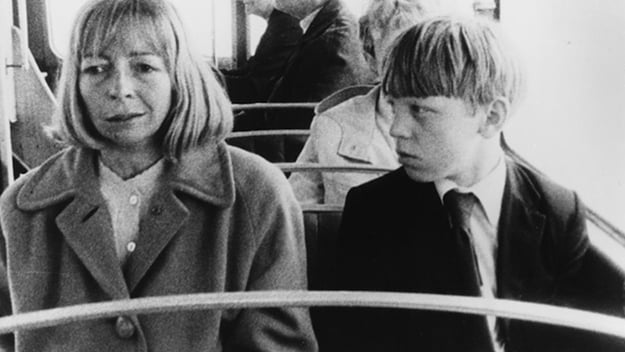
The world may never have experienced the blessed cinema of Terence Davies if not for an advertisement for the BFI Production Board he heard on BBC Radio in the mid-’70s. As he tells it, Davies, a twentysomething movie lover enrolled in drama school, then sent a short script to BFI on a whim. Davies had left school at age 15 before entering into a stifling office job, and had been fulfilling his creative desires acting with amateur theater companies, first in his hometown of Liverpool and then Coventry. He fully expected the BFI to ignore him, although a few short months later, he was invited to come down to their London office at the back of Waterloo station. There, he was met with the pragmatic enthusiasm of BFI’s then head of production Mamoun Hassan, a Saudi Arabia–born filmmaker and producer responsible for funding such experimental works as the Bill Douglas Trilogy (1972-78) and Franco Rosso’s Babylon (1980). Sensing untapped talent, Hassan told the newcomer that he’d have a budget of 8,500 pounds and that he’d direct the short himself. Davies had never even worked on a film set before.
Anyone acquainted with Davies’s cinema is aware of his highly unusual mix of raw personal emotion and exquisite formal patience. But his debut, Children (1976), might still come as a shock for just how astonishingly present his technical precision and willingness to plumb his own traumatic depths were even at this early stage. The film’s often audacious compositions are consistently borne out of a desperate need to tell the story of his own tortured youth and conflicted sexuality with fidelity to his own emotional reality. Davies has remained somewhat controversial in his status as a queer filmmaker for the distinct lack of pride and positivity evinced in his cinema; he once told me during an interview, “I’ve always had the greatest difficulty accepting being gay. I don’t like the gay scene at all,” and, in 2011, when he was 66 years old, he told The Irish Times online, “Being gay has ruined my life. I hate it. I’ll go to my grave hating it.” For these reasons, Davies, who grew up in the 1950s and 1960s, when sex between men was outlawed in the U.K., has occasionally been left out of conversations and lists of the great gay filmmakers, as though valid queer artistry must match up with progressive ideals. Yet it is Davies’s honesty and uncompromising aesthetic commitment to his own ambivalence that indeed makes him one of the greatest queer filmmakers of all time, his devotion to his own internal conflicts resulting in a contradictory voluptuous restraint expressive of the repressive social mechanisms that defined so much of his and our 20th century.
Many films throughout Davies’s career would reflect the mix of shame and ecstasy, nostalgia and fear, that gripped and defined Davies throughout his Liverpudlian childhood and into adulthood, including his masterpieces Distant Voices, Still Lives (1988) and The Long Day Closes (1992), and his essay film Of Time and the City (2008). Less abstract, though already gravitating toward the radical nonlinearity that would define so many of his personal films, Children and the two subsequent shorts that would comprise the remarkable Terence Davies Trilogy, Madonna and Child (1980) and Death and Transfiguration (1983), remain his purest wails of anguish. Children may appear to be the most primitive of Davies’s films, but it’s hardly amateur. Its simplicity of form belies a complex network of narrative crosshatches; it’s like a rich novella scrawled across a chalkboard.
What at first feels like a reminiscence of a miserable childhood gradually becomes something trickier to negotiate. Children’s first 15 minutes detail the abuse and mockery heaped upon Robert Tucker, a fair-skinned lad of about 12, by the equally brutal classmates and adults at his Catholic school. Davies begins by panning the camera across the pitiless expressions of a trio of bullies who tease poor, wan Tucker (“Who’s a fruit, then?”) before beating him up in the schoolyard. After the boys disperse, the title silently comes up over the image of Tucker bent over and clutching his head, a clear indication that the film has little interest in portraying adolescence with any wistfulness. The film doesn’t even make it particularly easy to pity passive Tucker (Phillip Mawdsley), who, with his mouth permanently agape in impenetrable diffidence, is hardly an ingratiating victim. After getting into another scrape in the hallway with one of his three terrorizers, Tucker is reprimanded by the schoolmaster, who mercilessly whacks his hand with a cane; in the following scene he’s whacked on the back of his head for staring off into space. Tucker’s well-trained response to both older authority figures is a curt “Yes, sir, thank you, sir.”
Thus far, Davies’s prosaic 16mm black-and-white photography and his austere directorial approach—largely static compositions, lack of music on the soundtrack, affectless performances—seem to indicate a kind of vérité realism. Yet at about the 14-minute mark, the film breaks away from its path slightly. Tucker outruns his predatory peers after school, making it to the safety of his family’s row house, and Davies cuts to what looks like a doctor’s waiting room, the camera panning across a series of emotionless faces before resting on a balding, haunted-looking adult man (Robin Hooper) with the same thousand-yard stare as young Tucker. The film then cuts to the boy again as he prepares to shower at an indoor public swimming pool, then back to a medium close-up of the man staring from his waiting room seat, then back to the pool, indicating that we’re experiencing the character’s subjective flashback. Soon enough we see the reason why the man is remembering this moment from his childhood; young Tucker notices a handsome, much older boy who has entered the shower. Most of the other children scatter, but Tucker remains transfixed by him. Eyes closed, oblivious to the attention his body is getting from the fascinated child, the man bathes with the abandon of a true exhibitionist, at one point putting his hand down the front of his skimpy bathing shorts to wash his genitals. The memory is both erotic daydream and site of trauma, the sexual awakening that was also something like a death.
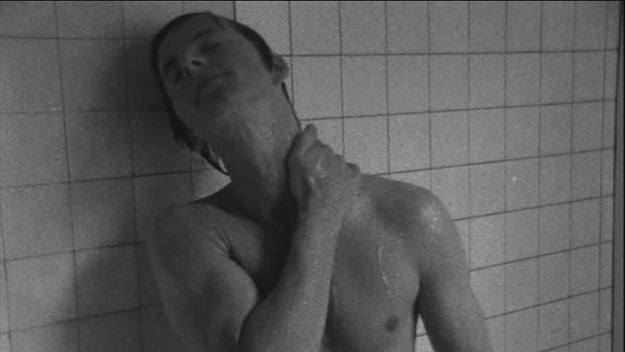
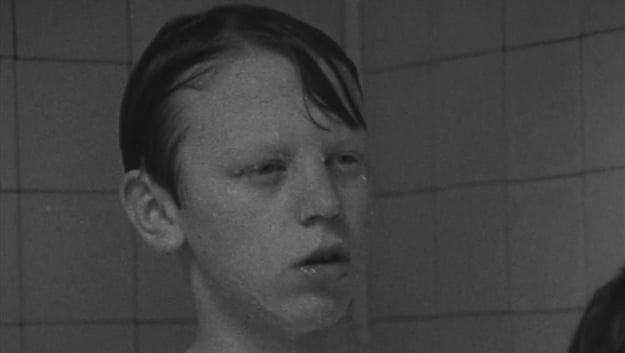
When Davies cuts back to adult Tucker, he’s consulting with a psychiatrist who barely looks up at him from his desk. After some requisite doctor-patient banter that serves to humiliate the man (“Still no interest in girls? Well, that may come”), he prescribes antidepressants and sends him on his way. We’re then back in the past again, and the slippage continues from this point forward, the back-and-forth movement of the timeframe indicating that Davies isn’t as interested in constructing a narrative of strictly motivated flashbacks as he is in expressing something about the stasis caused by emotional trauma. At one point, adult Tucker arrives home at his anonymous concrete high-rise; after he opens the door to enter his apartment, Davies cuts inside and suddenly we see pubescent Tucker again, walking into his childhood home. It’s a simple gesture—just one quick edit—but it speaks so much to the idea that he hasn’t moved on. Both versions of Tucker are united into one, equally stunted by repression, fear, and memory.
That Tucker is very much Davies’s surrogate makes this stasis all the more harrowing. Upon re-entering the house, the boy is immediately met with the agonized moans of his sick father. Peering from outside an open bedroom door, Tucker spies the man screaming in pain and writhing on the floor; a nurse enters the room, helps lift him into bed, pulls down his pajama bottoms, and injects a humiliating needle into his bare ass, presumably morphine. Lest we feel sympathy for the man, the following sequence jumps ahead (or perhaps flashes back further) to an uncozy scene by the fireplace, in which Tucker, his perpetually frozen mother, and his accusatory father sit stock still in a grim tableau. The father sends the lad to bed, after which, in a rage brought on by manufactured jealousy, he savagely beats his wife. We hear but do not see the violence, along with Tucker, enduring what is surely one of many such displays of domestic abuse from the cell of his bedroom.
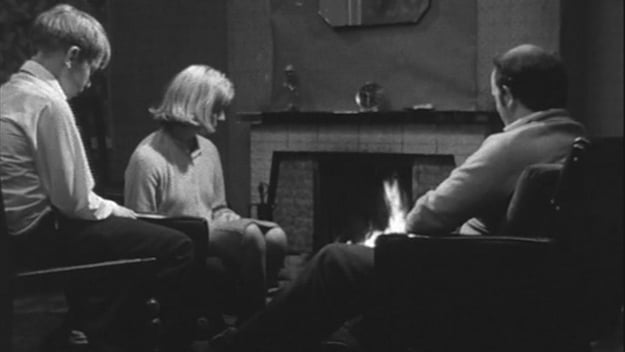
Davies has often spoken of the psychotic abuse of his father, who died when he was 7. This would also become the central theme of Distant Voices, Still Lives, which is split into two halves, before and after the death of the family’s vicious patriarch, and surveys how the man still quietly haunts them all years after the fact. The Long Day Closes drifts through the mindscape of an on-the-verge gay child who represents Davies in the poignant, brief period after his father’s death and before puberty, which he has said were his happiest years. Both of those films and Children are fueled by unsettled, contradictory emotions around the death of the father, no more conflicted than at the end of the film when, upon seeing his father’s dead body being carried out of the house for the funeral, Tucker breaks out into a gleeful smile, a jack-o’-lantern-like rictus hidden from his mother—it’s the first time in the film that the boy has seemed “happy.” But just a few scenes later, Tucker, again perched at the window, is morose, weeping uncontrollably and wailing, “Oh, Dad!” Could the boy possibly miss the father he so despised? Or is he acknowledging that he has been so long held in thrall by his violence? Or is he facing the terror of change, of the death of his own childhood?
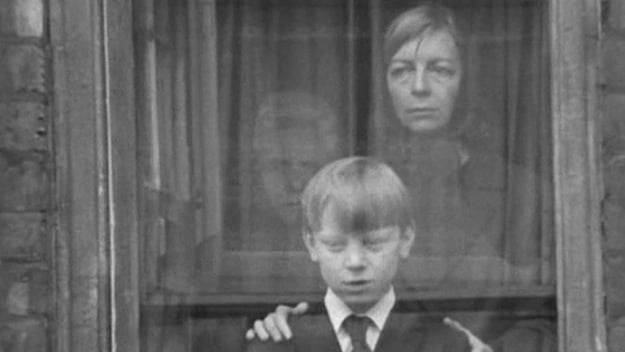
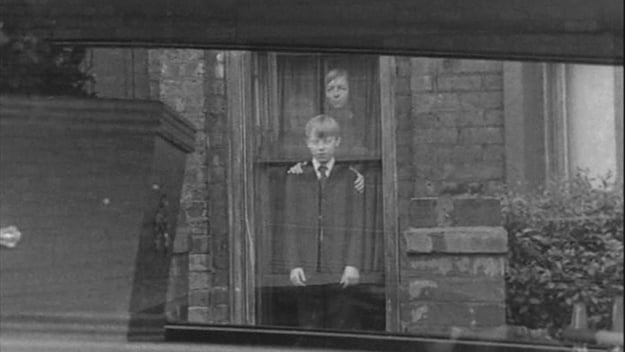
One of the single greatest shots in Davies’s career seems to convey all this at once. Tucker, flanked by his mother and an older woman—possibly a grandmother—watches from the window as the coffin is carried out; the initially tight frame zooms out from this stoic, funereal trio, though their image seems somehow to hover in front of the glass and curtains, as if they’re already floating ghosts. As the lens continues to zoom back, the coffin is slid into the back of the hearse parked in front of the house, and the left-to-right motion acts as a wipe, erasing the family from the image, though the reflection of the house’s window remains intact. Davies and cinematographer William Diver achieved this by placing the camera in a window across the street and creating a double reflection in the windows of the house and the hearse. The effect is ghostly, frightening, and moving, expressing death but also perhaps promising a clean slate. The image also appears singular in Davies’s oeuvre because of his use of the zoom, which creates an uncanny effect unseen in his other films, in which he came to prefer the tracking shot for its ability to travel through space rather than be anchored in it.
Of the films in his Trilogy, Davies told me, “I was at my lowest ebb when I was writing it and shooting it . . . I certainly couldn’t sit through the Trilogy again. It’s too painful. And quite frankly, I don’t know why people do watch it. It’s terribly miserable.” Aside from Davies’s aesthetic brilliance, which is notable from the very beginning, perhaps we still do watch these films because of the strange catharsis that’s so palpable in their very form. That we’re watching the tortured excavation and examination of trauma doesn’t make the film unbearable; rather it brings us closer to its maker. Great art, after all, should give us a feeling of intimacy, of conspiracy. Children looks back with clear, if wincing, eyes. In Madonna and Child and Death and Transfiguration, and his grim, explicit 1984 novel Hallelujah Now, Davies would continue Tucker’s saga, imagining a feared future instead of remembering a desolate past. The films may not be strewn with images of positivity, but they do chart a kind of progression: life as attempted exorcism.
Michael Koresky is the Director of Editorial and Creative Strategy at Film Society of Lincoln Center; the co-founder and co-editor of Reverse Shot; a frequent contributor to The Criterion Collection; and the author of the book Terence Davies, published by University of Illinois Press.







